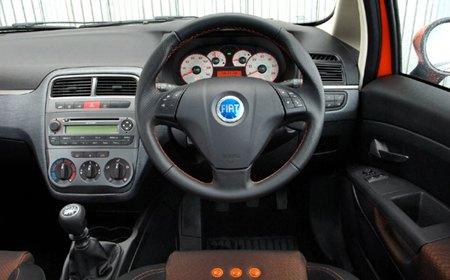2008 Fiat Grande Punto Review
GM Global Product Maven Maximum Bob Lutz claims that satisfying new U.S. federal fuel economy regulations will cost the consumer an additional $6k per car, on average. That seems a bit of a strange statement, as there are already plenty of cars capable of besting the freshly-minted mandate. From Japan to Jerusalem, from Mumbai to Milan, the world is filled, and filling, with suitably fuel efficient passenger cars. The real question is whether or not America is ready– make that “willing”– to buy the same sort of frugal machines that the rest of the world has been driving for years. Take the Fiat Grande Punto. Please.
Despite the word “Grande,” the Punto is 158 inches long– a little longer than the ten foot pole with which most American Camry drivers wouldn’t touch an Italian car. Thanks to oversized details like swept back headlights and chunky door handles, the Punto doesn’t look especially small. The gorgeous front end evokes the, gulp, Maserati Coupe GT. The sides are sporty without the usual cheese wedge demeanor. The back end is wonderfully chunky and perfectly tidy.
In short, literally, after the MINI Cooper, the Punto is proof positive that manufacturers needn’t beat small, inexpensive cars with the fugly stick (I’m almost looking at you, Toyota Yaris).
The Grande Punto’s interior is its weakest link: a totally unremarkable design with materials appropriate for an American car that cost about $13k. Mercifully, Fiat has blessed the car's rock hard plastics with a pleasant matte finish. And the panels line-up with such precision you’d think the Italians drafted in some anal-retentive Swiss or Germans workers to screw the Punto’s interior together. (It’s the robots, stupid.) While bland, the cabin creates the impression that the Punto is well-assembled– a notion that no Italian car should be without.
Despite the Punto’s largely urban remit, the seats are built for the long haul. And you can forget the Italian astronaut driving position (if you like); the helmsman’s throne has manual adjustments out the wazoo. Space is also well managed; there’s plenty of room in the back for two adults or three Gumbys. Drop the second row, and the hatchback accommodates all your Euro-commodities.
The driving experience reveals the Fiat Grande Punto as a mini (no caps) masterpiece. We begin with the fizzy, crackling engine. Don’t let its 77 horsepower output fool you. Scientists from the Research Institute of Research have released a study that proves it is impossible to drive the Grande Punto without a shit-eating grin. Wind it all the way up, dump the clutch, wind it up again, and continue. For an engine with about half the displacement of a pair of galoshes, it sounds magnificent. Two valves per cylinder? Who gives a damn when it sounds like you’ve got a micro Ferrari.
The optional Duodrive semi-automatic transmission is like the one bar in Times Square that’s worth visiting. It’s a computer controlled five-speed manual transmission (like the high-performance transmissions in Maseratis, Ferraris, and Lamborghinis) with a clutch under the hood. Leave it in pure automatic mode and the computer will do everything for you. Or drive it in sequential mode and you may as well be driving a stick– without the clutch pedal.
The upshot to this system: it’s absolutely the closest any automatic transmission can come to feeling like you’re driving a manual. Gear changes are nearly instant. Volkswagen’s DSG is faster and smoother, but the Fiat feels every bit like the real deal. You’ll roll backwards on hills, neutral has a real use, and you can even feel light vibrations when accelerating from a standstill. The average American would no doubt bitch about an automatic with feedback, but Europeans have different tastes.
Again, the Fiat Grande Punto was designed for European cities. To wit: its over-light electronic speed sensitive steering. At velocities below 30mph, it’s like a videogame– which makes the Punto a breeze to drive around the average continental avenue’s absurd 135 degree turns. When you get up to speed, the steering tightens-up to give sporting drivers some of the weight they need for speed.
Understandably enough, the Punto’s suspension is more about comfort than sport. That’s what higher performance Puntos are for (with a whopping 100 horsepower). For a city car, the base model absorbs the abuses of urban roads extremely well– while preserving the fun factor. Cars with tiny powder keg engines beg to be flogged; the Punto’s suspension places the “S” over the “M.” There’s some body roll through the corners, but it’s less dramatic than you’ll find in a regular Civic or Mazda3.
The Fiat Grande Punto is a small, easy to maneuver car with a hoot of an engine, a ripping good transmission, great handling, an outrageous price and fantastic fuel economy. It's just not for Americans. So, uh, what is?
Latest Car Reviews
Read moreLatest Product Reviews
Read moreRecent Comments
- Fred I would get the Acura RDX, to replace my Honda HR-V. Both it and the CRV seats are uncomfortable on longer trips.
- RHD Now that the negative Nellies have chimed in...A reasonably priced electric car would be a huge hit. There has to be an easy way to plug it in at home, in addition to the obvious relatively trickle charge via an extension cord. Price it under 30K, preferably under 25K, with a 200 mile range and you have a hit on your hands. This would be perfect for a teenager going to high school or a medium-range commuter. Imagine something like a Kia Soul, Ford Ranger, Honda CR-V, Chevy Malibu or even a Civic that costs a small fraction to fuel up compared to gasoline. Imagine not having to pay your wife's Chevron card bill every month (then try to get her off of Starbuck's and mani-pedi habits). One car is not the solution to every case imaginable. But would it be a market success? Abso-friggin-lutely. And TTAC missed today's announcement of the new Mini Aceman, which, unfortunately, will be sold only in China. It's an EV, so it's relevant to this particular article/question.
- Ajla It would. Although if future EVs prove relatively indifferent to prior owner habits that makes me more likely to go used.
- 28-Cars-Later One of the biggest reasons not to purchase an EV that I hear is...that they just all around suck for almost every use case imaginable.
- Theflyersfan A cheaper EV is likely to have a smaller battery (think Mazda MX-30 and Mitsubishi iMEV), so that makes it less useful for some buyers. Personally, my charging can only take place at work or at a four-charger station at the end of my street in a public lot, so that's a crapshoot. If a cheaper EV was able to capture what it seems like a lot of buyers want - sub-40K, 300+ mile range, up to 80% charging in 20-30 minutes (tops) - then they can possibly be added to some lists. But then the issues of depreciation and resale value come into play if someone wants to keep the car for a while. But since this question is asking person by person, if I had room for a second car to be garaged (off of the street), I would consider an EV for a second car and keep my current one as a weekend toy. But I can't do a 50K+ EV as a primary car with my uncertain charging infrastructure by me, road trips, and as a second car, the higher insurance rates and county taxes. Not yet at least. A plug in hybrid however is perfect.






































Comments
Join the conversation
The Grande Punto and the Opel Corsa are actually the same platform, correct?
[...] earlier this year at the Web site The Truth about Cars, Justin Berkowitz noted that G.M.’s vice chairman of Global Product Development, Bob Lutz, [...]